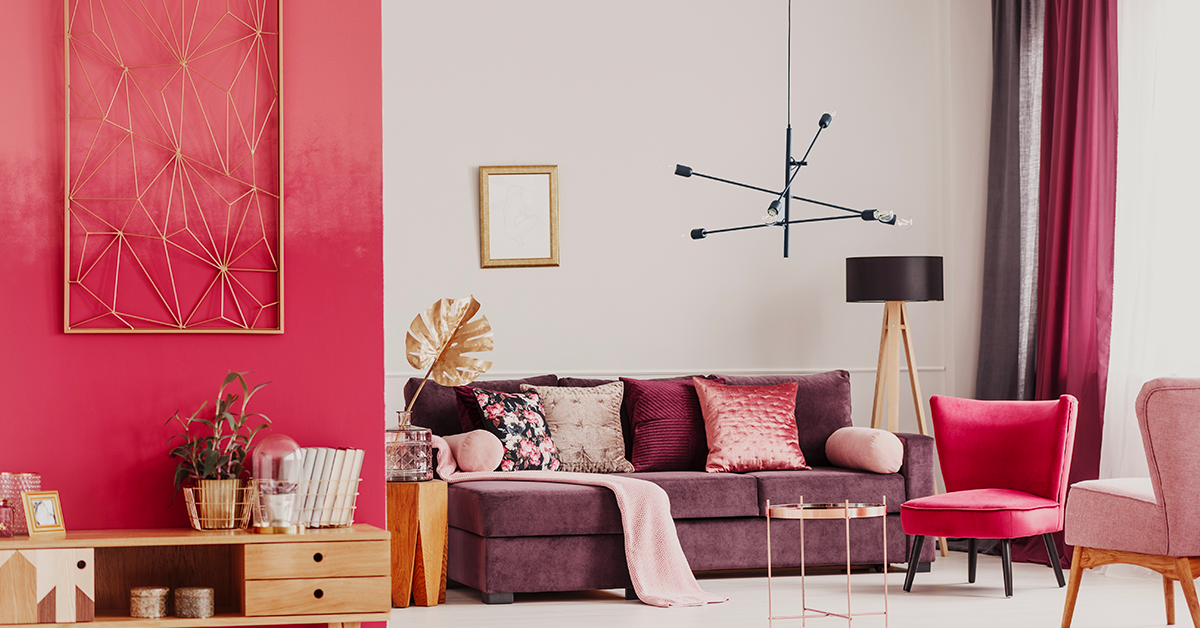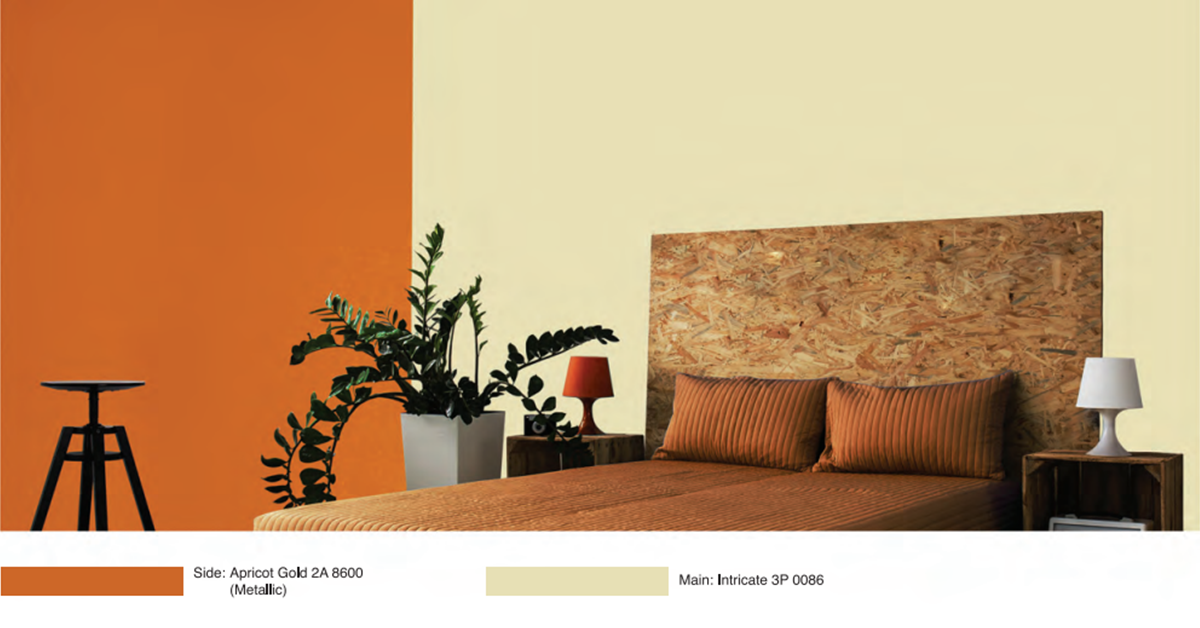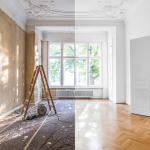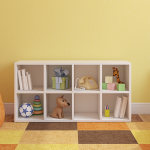Have you ever considered how a fabricated movie scene might cause us to feel the same way as the characters? We feel as the director wants us to feel because of the scene’s colour scheme. To change our mood, the colour scheme is quite important.
Therefore, you must be extremely picky when choosing two colour combinations for your ideal home, especially the bedroom, which is the most private area in the house. Your family’s individuality may be seen clearly in the colour scheme of your bedroom walls, making it tough for novices to choose and create the ideal scheme. So, picking the best colour for a room can be quite hectic.

Confusion is unavoidable when choosing among the many shades of a single wall paint colour since distinct wall paint colours come in different tones. So, we’ll be talking about things like Why Two Colour Combination is Important for Wall Design, Identifying complementary colours and How to Select the Ideal Two-Colour combination for Walls in this article.
Why are Two Colour Combinations a Key for Wall Design?
The reason is “contrast.” Contrasts are the foundation of every interior design or decoration. Without contrast, a room’s décor is boring. That’s why two colour combination for the living room is trending nowadays.
The goal of all modern room colours, or to be specific dual colour combinations, is to create harmony among the decor. Dual colour tones are fantastic and draw attention to or enhance the appearance and feel of the other color without being too overpowering.
The living room is the most significant of the several rooms in your home. The living area will be where the family and visitors will interact the most. Most families choose two colour combinations for living room walls rather than a monochromatic look, and it’s quite fair.
Living room colour schemes can have a stronger influence, so choosing carefully is critical and understanding how various colour combinations work. Depending on your preferences, dual colour combinations can be used to create a mood that is lively, subdued, tranquil, bold, passive, etc. So, you have a variety of possibilities to pick from based on what you’re looking for in life or how you prefer to live. So, two colour combinations for your room can be a great choice if you want to experiment with colours but don’t overdo it.
Finding What Colour Works Together
COLOUR WHEEL
Colours are represented visually on a colour wheel, where hues are grouped by wavelength. The Colour wheel demonstrates the relationship between primary, secondary, and tertiary hues, enabling colour relationships to be depicted geometrically. This helps to choose the best two colour combinations for the wall professionally.
The primary hues on the conventional colour wheel are red, yellow, and blue. Combining basic colours may give you secondary hues like orange, green, and purple.
- Orange is made up of red and yellow.
- Green is made up of yellow and blue.
- Purple is made when red and blue are combined.
Tertiary colours are then produced by combining secondary and primary hues. There are several variations of the colour wheel, but combining these three sorts of relationships, we may create a dozen colours. Paint combinations for walls are chosen based on this colour theory.
Cool Colours
Your brain is calmed by cool colours like green, blue, purple, and even grey. They are renowned for enhancing creativity and promoting relaxation. Compared to warm colour schemes, these cool colour combinations may help you perform better in tests and examinations. So, a simple two-colour combination for bedroom walls comprising of cool tones can help in good relaxation.
Warm Colours
Red, orange, and yellow are said to have energising properties and can evoke feelings of love, pleasure, and passion. Keep that in mind when choosing your two-colour scheme for the walls; choose warm hues if you want to feel invigorated when you wake up or if you want to inspire romance and happiness in your marriage.
How to Choose Perfect Two Colour Combination For Walls
Understand colour psychology
What do you feel when you go into a room? Do you feel a sense of peace sweeping over you? Do you feel upbeat and prepared to face the day? Or do you feel your body tensing up and desire to get away from your current situation? Colour is one of the key elements in interior design that helps establish the tone of a space. The psychology of room colours refers to this.
Two colour combinations are unnecessary for a room to originate from the same colour family. Bold, contrasting colours will catch the eye immediately, so use these to call attention to special elements in a space, such as raised panelling, artistic carving in a fireplace mantel, or mouldings around windows and doors. Combinations that are softer and more monochromatic might be as effective. Also, a cool tone two-colour combination for the bedroom can be a good option if you want calming effects.
Think about room type and effect
Is it possible to apply the same interior paint colour throughout the house? In theory, yes, but settings in one room may not be the same. The kitchen and the bedroom are not the same, just as the basement is not the same as the kitchen. Thus, Interior design colour combinations depend largely on room type.
The lighting, activities, and microclimates in various house rooms need the employment of various types of paint.
You may thus customise paint types and paint glosses to each room or surface, including the basement, kitchen, ceiling, bathroom, trim, and cabinets, whether you’re painting one or several.
Be strategic about room space.
Mirrors and white colours have traditionally been used to make small areas appear larger. However, did you know there are more methods to use colour in your house? To be more precise, the colour you choose and how you apply it may radically alter the appearance of your space. Or, even though you may have a little room, how you use it can make all the difference! We’ll give you a few pointers if you’re curious how paint impacts room size.
- Choose white or light colours to make a space appear airy and expansive. Your room will feel spacious and airy if the walls and ceiling are painted white or other delicate colours. Doing two-colour room painting is a little difficult, but once your need it, it’s real easy!
- Cosy and relaxing sensations go a long way whether you want to design a space that works best for close, private family chats or a room to watch movies and relax together. In this situation, you’d want to maximise the use of the space that is already there while maintaining a cosy aesthetic. Therefore, use a lot of paint in a deeper tone. That means you shouldn’t use colour on just one wall.
Note the furniture colours and style.
Furniture frequently has a bad image for being uninteresting, yet it can be quite fashionable in the proper environment. Selecting the right wall colours is the key to enhancing your favourite (and even your least favourite!) pieces of brown furniture, whether you have a chic chocolate-brown sofa that you can’t get enough of or your grandmother’s mahogany dining room table.
For furniture in a living room or dining room, brown is a flexible option because of the variety of emotions it may convey. A room with brown furniture or wood may be cosy and inviting, earthy and natural, elegant and refined, or completely glam, depending on what it combines. Mid-tone walls are the finest choice to go with a dark brown sofa or other pieces of furniture. Consider cosy golden yellows, mellow medium blues, peaceful greyish-greens, luscious tans, or calming greys if you have brown furniture.
Some Examples of Two Colour Combination for Walls

Lavender and Off-White
Off-white, grey, and other neutral hues are one of the best room paint colours that work well as a complement to lavender. Lavender may counteract the gloomy and subdued feeling given by cool neutrals. Its subtle beauty also exudes a sense of regal majesty and luxurious grandeur.
Grey and Yellow
Grey may reduce the brightness of yellows, while yellows can spice up cool-toned greys, so they go nicely together in a living room. To acquire the desired aesthetic, choosing the appropriate colours to mix together is important. So, this can be considered as one of the best two colour combinations out there.
Dark Blue and White
This is a very flexible combination since blue can be used to conjure a variety of various styles, from dramatic dining rooms to calming bedrooms. Blue is also a simple hue to add to your home with white.
Cream and Brown
Brown and cream work together to create a calming, airy, and cosy interior setting. To create lovely brown-cream colour schemes for cosy and vibrant home décor, all various cream hues look excellent with tones of brown. This is the best two-colour combination for the hall.
Peach and white
One of the most popular double colour combinations for bedrooms is peach since it has a calming effect and is simple to match with other hues. A great colour scheme for room walls that works well with minimalist home décor is sheer peach-hued and milky white walls.
Burgundy and Beige
Beige and Burgundy = Simple and Warm two colour combination for the room
A burgundy-coloured wall will brighten your entire bedroom. For a fresh atmosphere, layer the space with beige tones. Any bedroom may benefit from a modest accent wall in burgundy.
Yellow and Cream
Similar to gold, yellow and cream create a warm and distinctive environment. It breaks up the monotony and provides your house depth and contrast.
Mint Green and White
A living room with mint green and white colour scheme will seem perpetually new, especially if the area is well-lit since the colours will better capture and reflect light. So, choose a paint colour for the room that reflects your personality.
How Can Berger Paints Help You to Choose Two Colour Wall Combinations?
Before you start painting your walls, do it virtually!
With the aid of Virtual Painter by Berger, you may imagine how your interior might appear when painted in a specific combination of home painting colours. You can also consult with us for the final check based on it.
The first digital tool of its kind, our paint visualiser offers several enhanced features, including:
- Realistic visualisation – When applying a virtual colour for your home painting, the tool’s cutting-edge technology accurately visualises colours by accounting for room variables like lighting. We have paint colours for bedrooms, kitchen, hall and many more.
- Wall painting colour ideas – It’s easy to upload a snapshot of your house or use images of existing rooms to experiment with colour combinations, including bedroom wall colour ideas, living room wall colour ideas and many more. You can submit a photo to match colours, choose from colour families and curated colour palettes, search for particular colour names, or test colours online.
Also, try our Express Painting, Wall waterproofing and Interior wall paint solutions for a seamless painting experience!
Wall Paint Cost Calculator
Are you curious about the price of painting your house safely? You can now estimate the amount of paint needed with our paint calculator, which also helps you determine the paint area.
It will be easier to compare quotations from painting services if you know the cost of the paint you need to buy. Calculate the amount of paint needed to complete the project. To find out how much paint you’ll need for your house painting project, check out the helpful paint calculators that are readily available online. To determine the area that has to be painted, you can also use Berger’s Paint Calculator. It will estimate the quantity of paint needed for your project.
Conclusion
The proper use of two colour combinations on room walls may offer elegance and aesthetic interest. Your guiding principle for selecting the best colour for room walls should be comfort. The proper modern bedroom colour combination may transform it into a peaceful retreat inside the home. A person should be able to fall asleep peacefully at night thanks to the bedroom’s walls being painted in two soothing colours.
To choose the two colour schemes for the bedroom walls, consider the space’s size, the overall design concept, and the quantity and direction of natural light in the space.
So, stop thinking and start painting seamlessly with Berger!
FAQs
While painting a room with two colour combinations, which wall should be darker?
A cool, dark hue should be used on the walls next to windows to absorb light in overly-bright spaces. Paint the wall opposite the window, in a dark hue, to reflect light into the room if you desire a brighter space.
Can you paint two opposite walls the same colour?
Yes, with two opposing walls painted the same colour. Ideally, with appropriate colours, small, square rooms appear larger. The hue gives the room a sense of depth and opens it up. Similarly, a small room appears bigger if the longer walls are brighter and the shorter ones are darker. So, choosing two wall colour combinations can sometimes be tricky.
How to split a wall with two colours vertically?
To split a wall with two paint colours vertically, identify a point on the wall where you want the two colours to meet, apply the first colour past that point, make a vertical dividing line with a pencil or chalk, apply masking tape along that line, and then paint the remaining portion of the wall with the second colour.
How To Paint a Corner Where Two Colours Meet?
Here are six simple methods for painting a corner where two colours blend:
- Paint a single wall.
- Hold off till the wall is dry.
- Apply painter’s tape to the corner wall.
- Retouch the corner wall’s paint.
- Paint the other wall side.
- Peel the painter’s tape off.


 Get in Touch
Get in Touch
